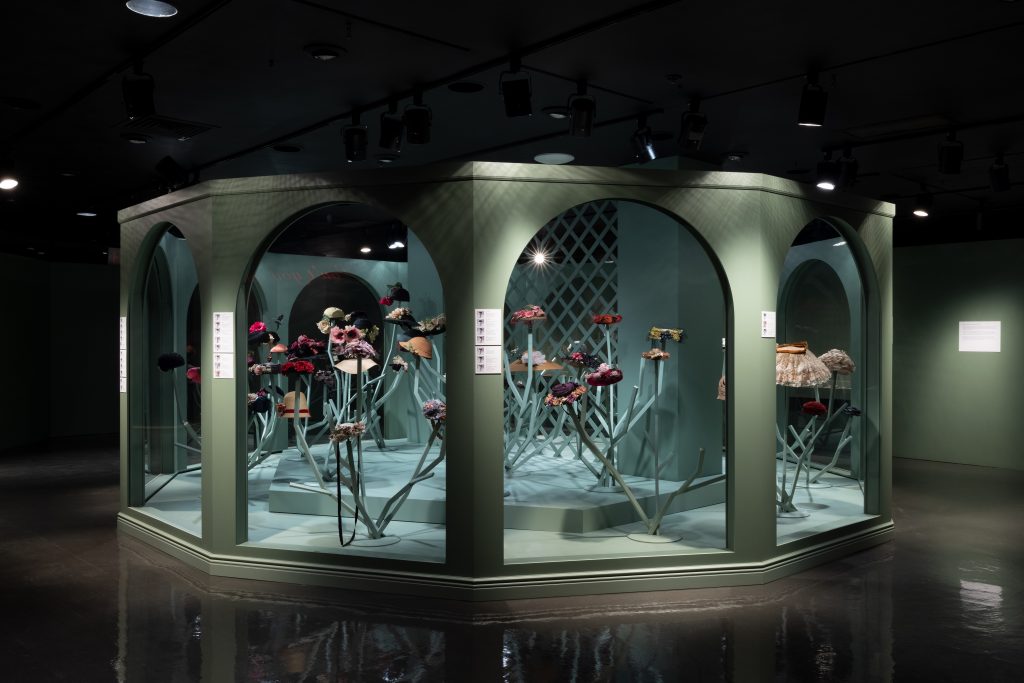Ravishing: The Rose in Fashion
‘Ravishing: The Rose in Fashion’ explores how the rose has influenced the way we look, dress, feel, and fantasize. The rose and the savage thorns that protect it—along with the symbolism and myths it has inspired—have long affected designers of fashionable dress, textiles, and accessories. This major exhibition foregrounds innovative and experimental designs, while recognizing that wearing or holding a rose can be transformative. In an effort to provide a safe environment, visitors are encouraged to plan ahead for their visit by reviewing the latest safety guidelines and protocols, available here. The exhibition features more than 130 items ranging from the most luxurious hand-woven and embroidered 18th-century silks to the latest gender-neutral catwalk trends. Items were selected from the museum’s world-class collection and include a large group of hats, many of which are displayed for the first time. The garments and accessories are interpreted in the context of themes such as love, beauty, sex, sin, gendered identities, rites of passage, transgression, degradation, and death.
Valerie Steele, director and chief curator of MFIT, said, “The Museum at FIT is reopening to visitors with a spectacular new exhibition on fashion inspired by the imagery and symbolism of the rose—whether crimson, pink, white, yellow, or black. Long associated with love and pleasure, the rose and its thorns can also allude to suffering, purity, and transience. Drawing on three centuries of fashion, this beautiful exhibition features work by designers from Charles James to Alexander McQueen. I am grateful to Amy de la Haye and Colleen Hill for co-curating what is sure to be one of our most popular exhibitions.”
The introductory gallery comprises a magical “rose garden of hats” from international milliners such as Lilly Daché, Mr. John, and Caroline Reboux, in addition to fashion design houses including Christian Dior, Lanvin, and Schiaparelli. Several hats are decorated with magnificent artificial roses, others are crafted to resemble the shape of the flowers, some appear to be composed from its petals, and others have been made from rose-patterned materials. A stunning, wide-brimmed, black horsehair hat, dating from circa 1908 and bedecked with a profusion of dark red silk buds and roses, has been expertly conserved for the show. Another, from American milliner, Mr. John, dates to 1950 and is called “Primavera.” Its rose-like form, strewn with pink cotton petals, is decorated with artificial wild roses, daisies, violets, and small yellow flowers. More modern is a dashing black top hat with a pink silk rose, designed by Stephen Jones in 2008 and specially remade for this exhibition.
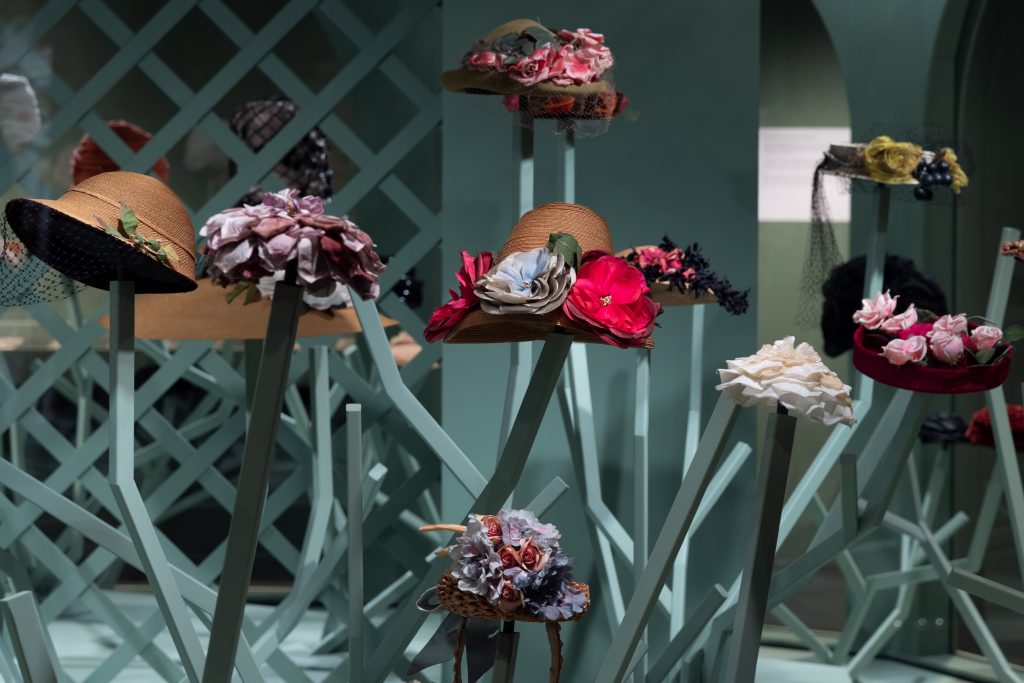
Detail of the rose garden of hats, which features styles from the 19th century to the 21st century.
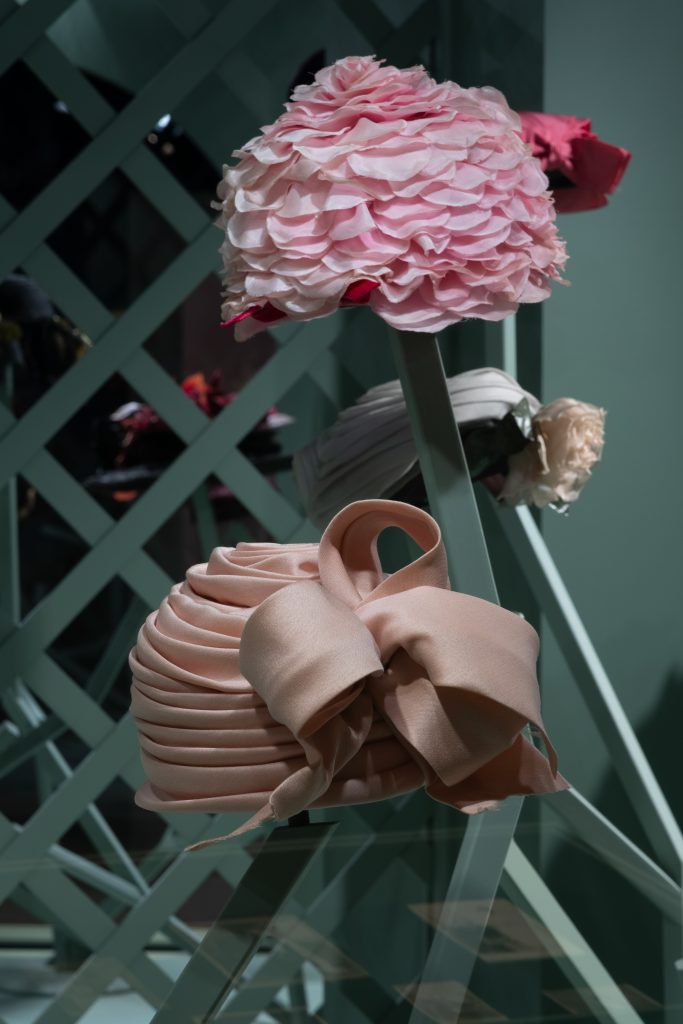
Two mid-20th-century millinery designs from the rose garden of hats.
The introduction to the exhibition includes more than 75 original photographic portraits of people wearing roses, both real and artificial, dating from the 1850s to the 1920s—a period when studio and amateur photography became increasingly accessible. These images, collected especially for the exhibition, reveal how roses were used regularly as studio props and had the power to transform their wearer’s dressed appearance.
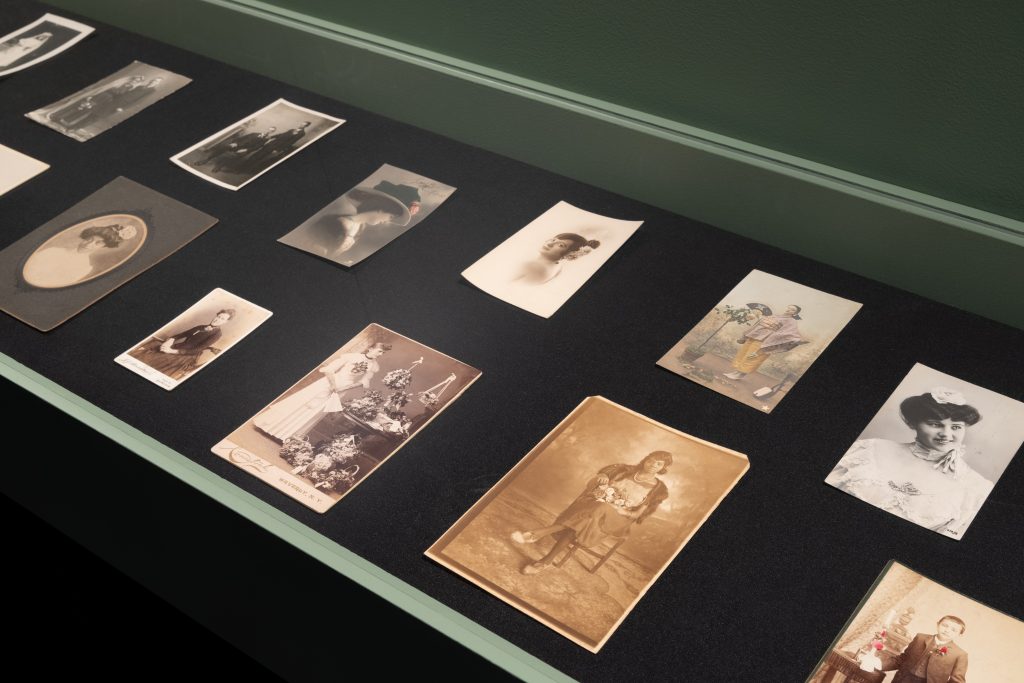
More than 75 photographs from the mid-19th through the early 20th centuries demonstrate how real and artificial roses could transform their wearer’s appearance.
The main gallery, the “rose garden of fashion,” has been designed with a romantic but edgy garden theme. It displays more than 50 ensembles arranged by color. The visitor first encounters a dramatic red rose–themed display inspired by “crimson joy,” a line in a William Blake poem from 1794. The red rose is widely associated with love, passion, and devotion, particularly among females, and this section includes women’s clothing by labels such as Comme des Garçons, Dior, Halston, and Alexander McQueen. An ensemble by Noir Kei Ninomiya—newly acquired for this exhibition—takes the form of a rose but rebuffs any notion of fragility that may be associated with the floral or the feminine.
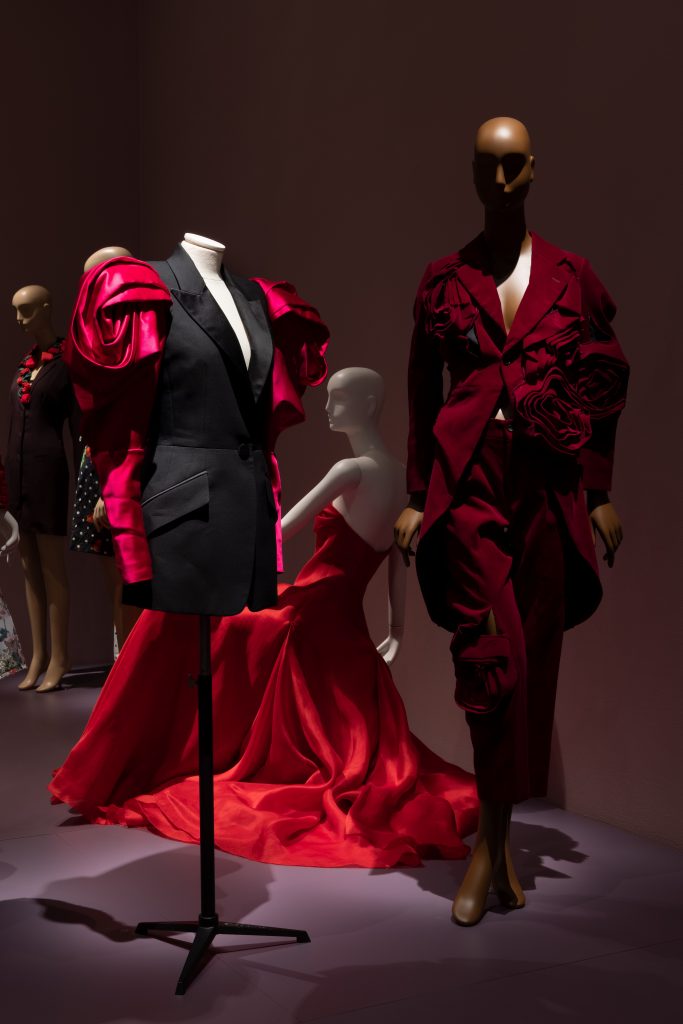
Garments with red roses. From left to right: a jacket by Alexander McQueen, a gown by Halston, and a pantsuit by Comme des Garçons.

Dresses highlighting red roses. From left to right: an evening gown by Luis Estévez, an ensemble by Thom Browne, a dress by Anna Sui, and an ensemble by Noir Kei Ninomiya.
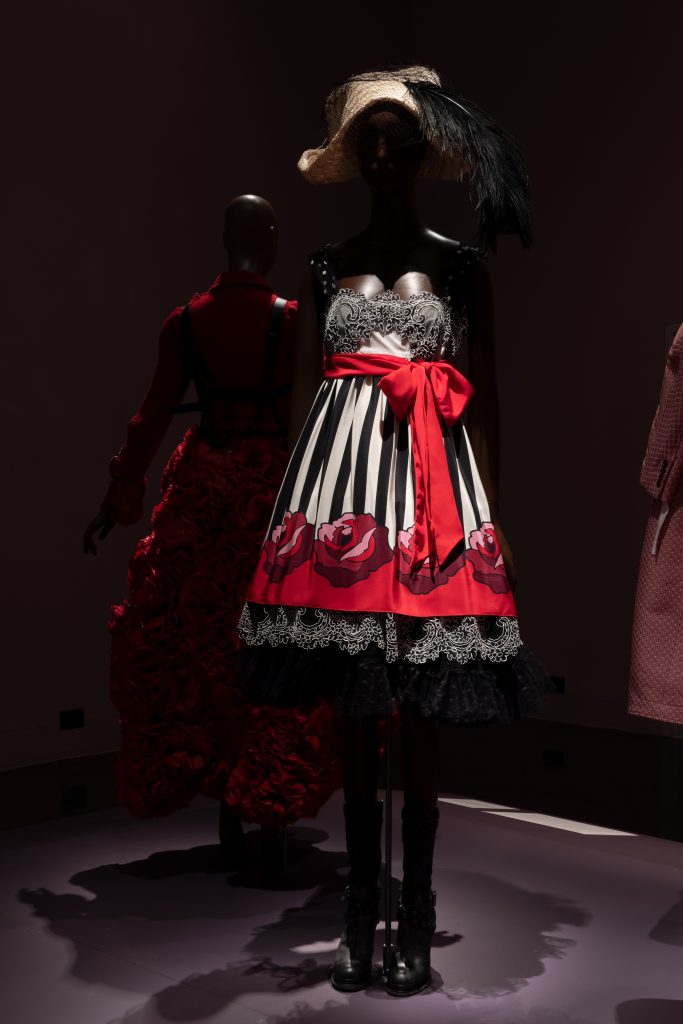
A dress by Anna Sui, printed with red roses.
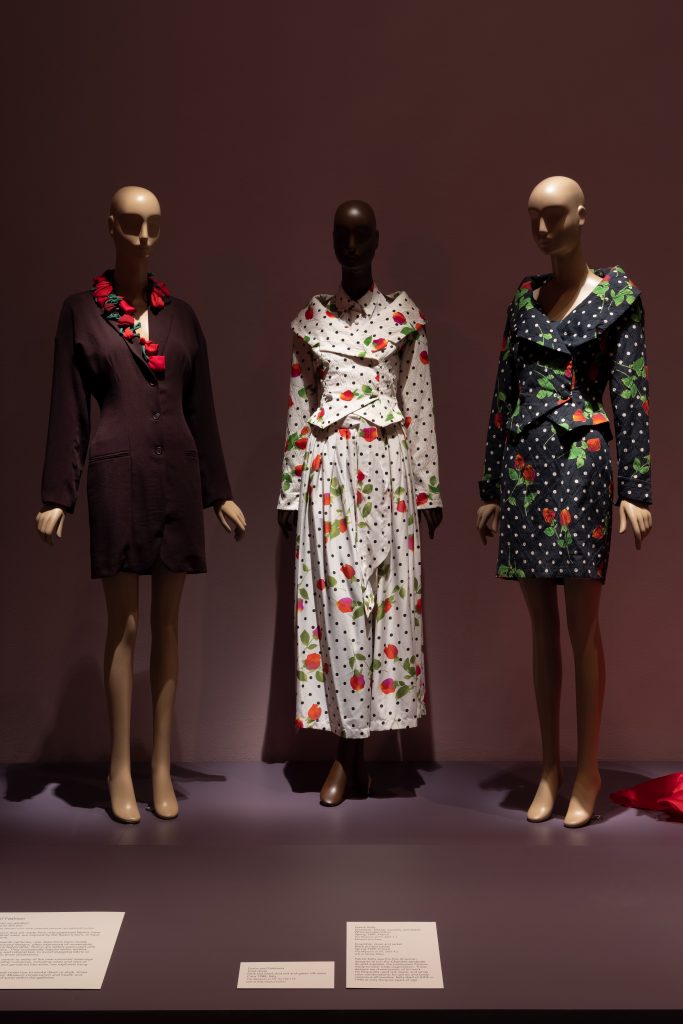
From left to right: a coat dress by Dolce and Gabbana and two ensembles by Patrick Kelly.
Another section focuses on the use of the colors white and pale pink. Since Ancient Rome, the rose has marked rites of passage—from birth through marriage (for some), the loss of virginity, and death. White and pink roses became associated with young females and have thus been frequently used for dresses worn by debutantes. Charles James’s 1937 gown, worn by New York debutante Esme O’Brien, features a boned corselette bodice. It was designed in the Neo-Romantic style, which took inspiration from late 19th-century fashion. Although many of James’s silhouettes have been likened to flowers, his use of artificial blooms was rare and spectacular. Another garment in this section is a newly acquired dress from circa 1810, made from sheer white cotton embroidered with a meandering, naturalistic motif of roses at the hem, evocative of youthfulness and spring.
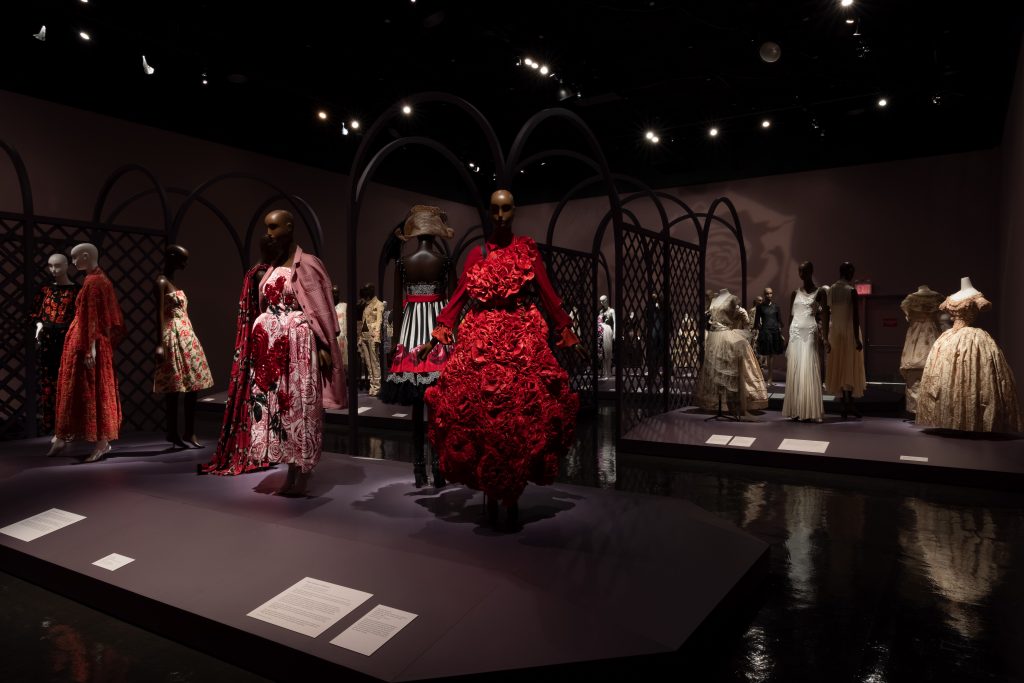
An overview of the main gallery, featuring rose-themed garments in shades of red, white, and pink.

Garments featuring a “mixed bunch” of roses. From left to right: a gown from the 1840s, a cocktail dress by Norman Norell, an 18th-century robe à la française, two 18th-century corsets, and an evening gown by Jean Dessès.

An overview of the main gallery, featuring a dress by Agnès and a pantsuit by Robert Cavalli (center).
The black rose can symbolize fated love, tragedy, and death. Although there are no truly black flowers in nature, the idea of them has proved compelling. There are many black roses in fashion design, where they acquired a glamorous and/or transgressive allure, frequently depicted within lace patterns. Cristóbal Balenciaga referenced his Spanish heritage by using black lace, worn by the clergy and the monarchy since the late 18th century; the exhibition features a two-piece cocktail ensemble from 1963 from Balenciaga, made from rose-patterned Chantilly lace, layered over black satin. In complete contrast, a future-forward, disposable “paper” dress from 1968 features a screen-printed oversized image of a rose.

Garments demonstrating the theme of black roses. From left to right (facing the viewer): a printed “paper” dress by Harry Gordon, a dress by Rodarte, a jumpsuit by Alexander McQueen, and an evening dress by Robert Piguet.

A black rose-themed ensemble by Thom Browne.
Finally, a group of garments representing a “mixed bunch” of roses features the flower in yellow, blue, and other colors. This section also highlights that the rose was—and is—significant within men’s fashion, and more recently within gender-neutral designs. Roses have featured prominently in the collections of Alessandro Michele, creative director at Gucci. The exhibition features a suit by Michele made from dark blue silk and woven with a design of pink roses, that formed part of his last dedicated menswear show. Charles Jeffrey’s “Rose-scribble” printed fabric, used to fashion a man’s coat, is characteristic of the designer’s use of bold color and graphic patterns. Neil Grotzinger, designer for the label NIHL, creates gender-neutral collections that explore notions of masculinity, queerness, power, and sensuality. His two-piece ensemble is made from rose-patterned lace, with trousers spray-painted in shades of gray, brown, red, and orange.
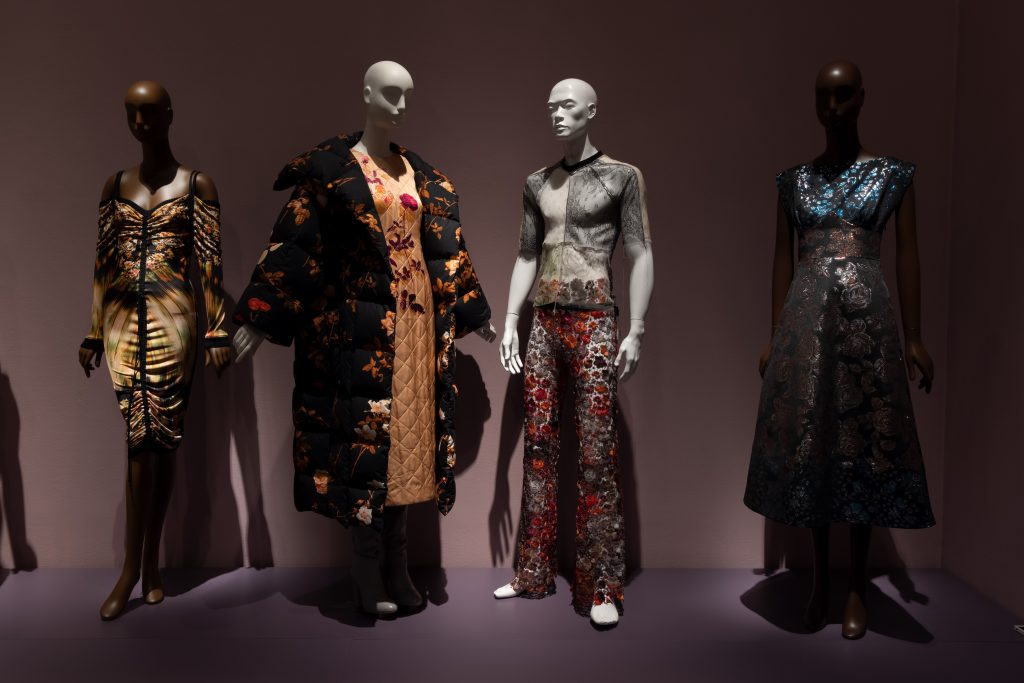
Charles Jeffrey’s “Rose-scribble” printed fabric, man’s coat (second left) and Neil Grotzinger’s gender-neutral two-piece ensemble made from rose-patterned lace (center).
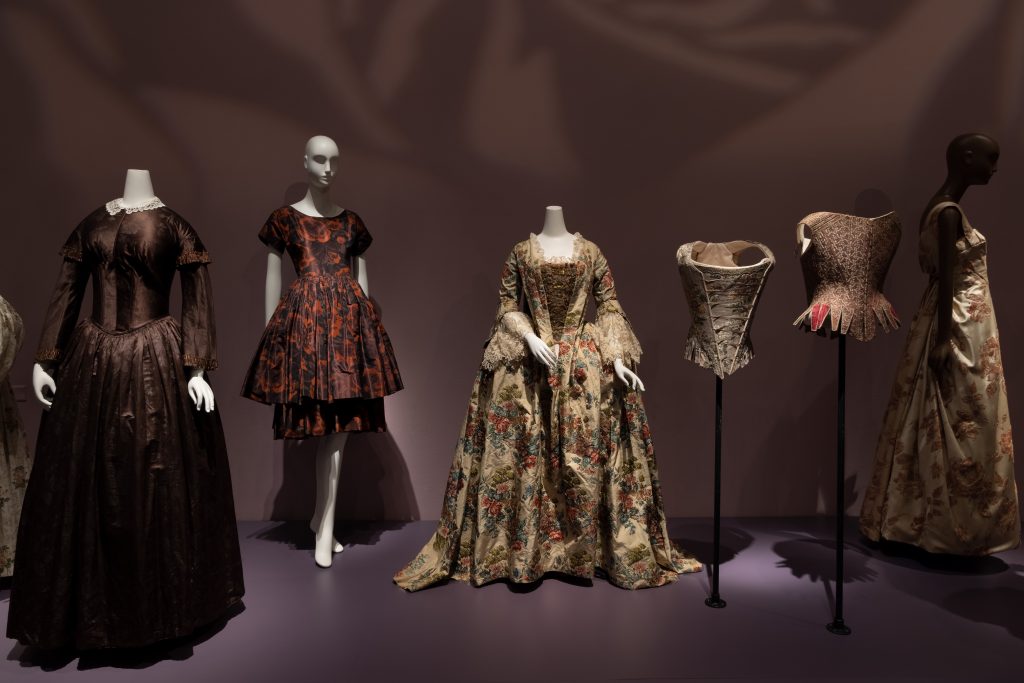
Garments featuring a “mixed bunch” of roses. From left to right: a gown from the 1840s, a cocktail dress by Norman Norell, an 18th-century robe à la française, two 18th-century corsets, and an evening gown by Jean Dessès.
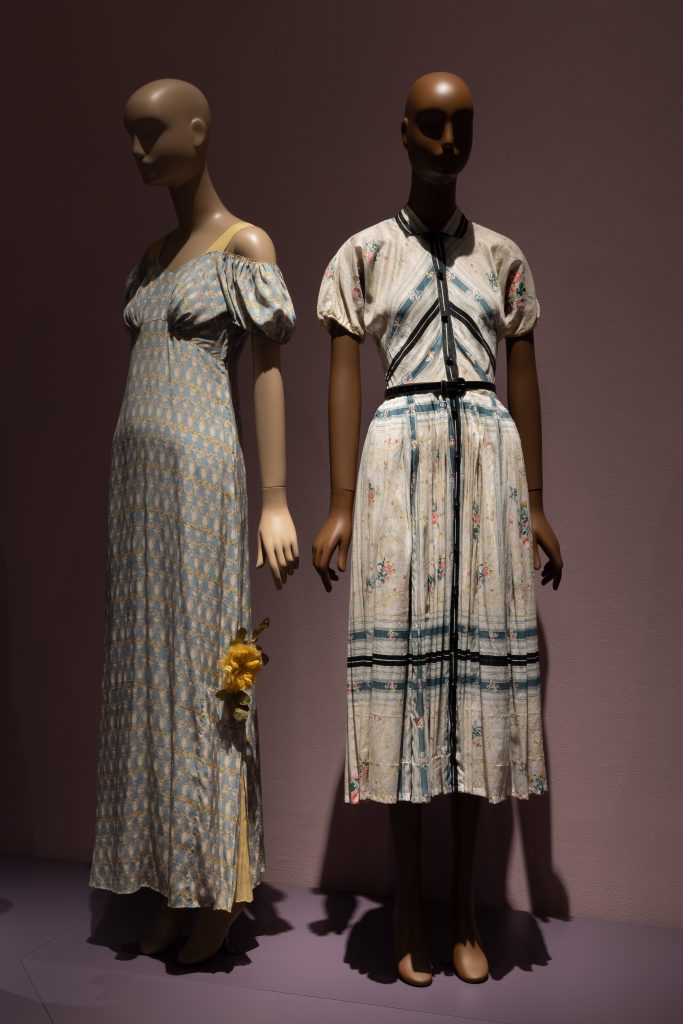
Garments with roses in shades of yellow, pink, and blue. From left to right: a 1930s dress, possibly by Molyneux, and a dress by Claire McCardell.
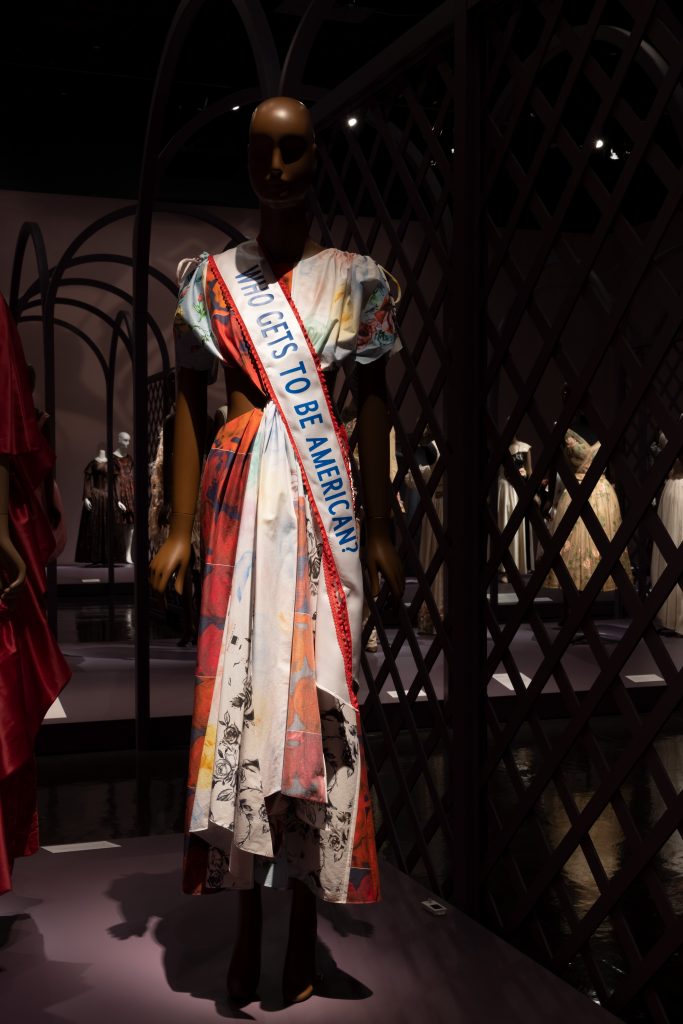
A rose-printed ensemble by Prabal Gurung
The exhibition is curated by Amy de la Haye, Rootstein Hopkins Chair of Dress History and Curatorship and joint director of the Centre for Fashion Curation at London College of Fashion, with Colleen Hill, curator of costume and accessories at The Museum at FIT.
Ravishing: The Rose in Fashion leads the first phase of MFIT’s reopening, following its 2020 closure when FIT moved to remote learning due to the pandemic. A fall exhibition will be announced shortly, in addition to virtual Fashion Culture programming.
Publication
Ravishing: The Rose in Fashion (published by Yale University Press and now available) is written by Amy de la Haye. It includes a conversation, “On Roses,” with famed photographer Nick Knight, in addition to contributions from fashion historians Jonathan Faiers, Colleen Hill, Mairi MacKenzie, and Geoffrey Munn.
Symposium
A virtual companion symposium held on April 30, 2021 features talks by exhibition co-curator Amy de la Haye and fashion historians Jonathan Faiers and Mairi MacKenzie. It also includes a conversation between MFIT curators Colleen Hill and Elizabeth Way.
Visiting the Museum
The museum will be open Wednesdays, Thursdays, and Fridays from noon to 8 pm, and Saturdays and Sundays from 10 am to 5 pm. Admission is free. To avoid overcrowding, groups of people entering together should consist of no more than five friends or family members. MFIT hopes to increase capacity in the near future. Additional safety measures include social distancing, hand sanitizer stations, and the removal of high-touch areas such as interactive displays, seating, and brochure kiosks. It is mandatory that all visitors, regardless of their vaccination status, wear a face mask while in the museum. All visitors are requested to review the latest safety guidelines and protocols, available here.
Ravishing: The Rose in Fashion has been made possible thanks to the generosity of The Couture Council of The Museum at FIT.
Ravishing The Rose in Fashion Press Release FINAL 7-21-21
All images © The Museum at FIT
